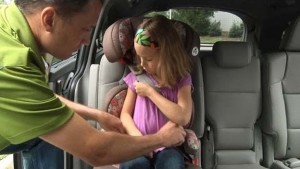
Despite a decade-old federal mandate, a new study says it's still extremely difficult to accurately install a child safety seat in most vehicles.
The news is not good for parents who have counted on child safety seats to keep the kids out of harm’s way in the event of an accident. Despite toughened federal standards and industry efforts, only 21 of 98 vehicles met the requirements for ease of use, and seven of the latest vehicles failed entirely in a new series of tests.
That’s a surprise considering it’s been a decade since federal regulators first mandated the Lower Anchors and Tethers for Children, or LATCH system. The rule, which went into effect with the 2003 model-year, required manufacturers to simplify the process and make it easier for parents to be sure a safety seat is properly installed.
But despite that, “Installing a child restraint isn’t always as simple as a couple of clicks and you’re done,” warned Anne McCartt, senior vice president for research with the Insurance Institute for Highway Safety, the IIHS, which conducted the new test in cooperation with the University of Michigan Transportation Research Institute, or UMTRI.
More than three-quarters of the vehicles tested failed to meet at least some of the requirements for ease of use. And seven didn’t meet any of the standards, according to the study. Among other goals, LATCH was meant to ensure that it didn’t require brute force to install a safety seat and that the appropriate anchors were not just installed in a vehicle but easy to find and use.
The IIHS/UMTRI test involved 36 volunteers who were asked to install three different car seats in various vehicles. Each was expected to accurately complete at least eight seat installations in a three-hour period. But, in the end, the volunteers completed the installation correctly only 13% of the time.
“The problem lies with the vehicle, not the user,” says co-author McCartt.
But automakers insisted they are not necessarily to blame. “Ease of use,” said a statement from Ford, “is highly dependent on the design of the child-restraint hardware that attaches to the anchor.”
Of particular concern, researchers said, is the fact that many of the models that failed the test are being marketed as “family vehicles.” Among the seven that flunked on all the testing criteria are the Toyota Sienna minivan and Ford’s Flex “people mover,” its minivan alternative.
In some cases, vehicles flunked because it required more than 40 pounds of force to install a seat. In others, latches were not visible or the way the factory seat was constructed made it difficult to reach the LATCH anchors. IIHS and UMTRI found the best vehicles placed the lower child seat anchors less than three-quarters of an inch below the bight – the point at which a car seat’s back and bottom seat cushions come together.
The results of the latest study are particularly disappointing because there appears to be little progress in improving the effectiveness of child seat latch systems despite repeated warnings. In 2004, the National Highway Traffic Safety Administration issued the results of a study that found “critical misuse” in the installation of three-quarters of child safety seats and booster seats.
But parents also took some of the blame in a September 2011 study by Safe Kids USA. It found that parents were using the top tethers to fully restrain forward-facing child safety seats only 28% of the time. And even among those who did, the installations were done correctly only 59% of the time.
According to the new IIHS/UMTRI study, the hand-chosen volunteers still only used the upper tethers 48% of the time and only 54% got the installation right.
“Tethers should be used with all forward-facing child restraints, even if parents opt to secure seats with safety belts instead of lower anchors,” said co-author Klinich, of UMTRI. “We need to better educate people about tether use.”
The new report concludes that parents are 19 times more likely to use the LATCH system correctly in the 21 vehicles that passed the latest test.
Here’s the list of vehicles covered by the IIHS/UMTRI study:
2011 models that meet all 3 easy-installation criteria
- Audi A4 Quattro
- Cadillac Escalade
- Chevrolet Equinox LT
- Chevrolet Silverado 1500 crew cab
- Chevrolet Suburban LT
- Chevrolet Tahoe LS
- Chrysler Town & Country (2010)
- Dodge Caliber Mainstreet
- Dodge Grand Caravan Crew
- Dodge Ram 1500 crew cab
- Ford Escape XLT
- Ford F-150 SuperCrew Cab
- GMC Sierra 1500 crew cab SLE
- Honda Pilot EX-L
- Kia Sedona LX
- Land Rover Range Rover Sport
- Mercedes-Benz C300
- Mercedes-Benz E350
- Mitsubishi Eclipse coupe GS
- Mitsubishi Lancer ES
- Toyota Tacoma extended cab
2011 models that don’t meet any easy-installation criteria
- Buick Enclave CX
- Chevrolet Impala LT
- Dodge Avenger Express
- Ford Flex SEL
- Ford Taurus Limited
- Hyundai Sonata Limited
- Toyota Sienna XLE
